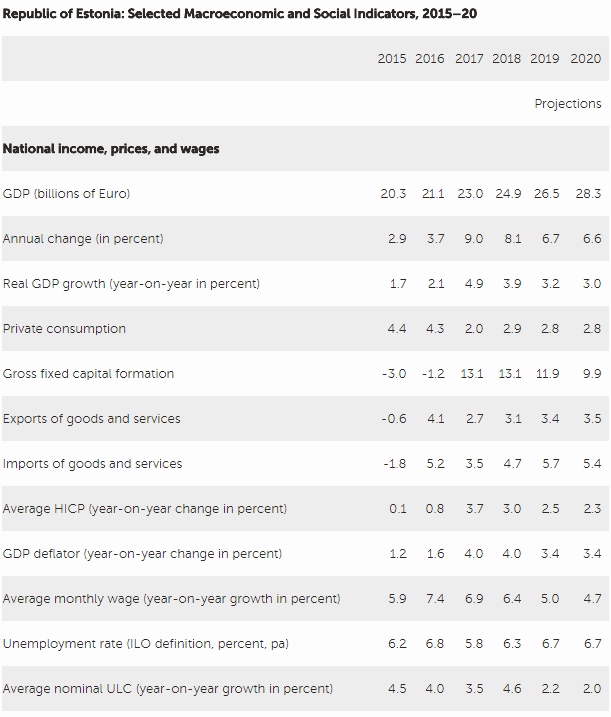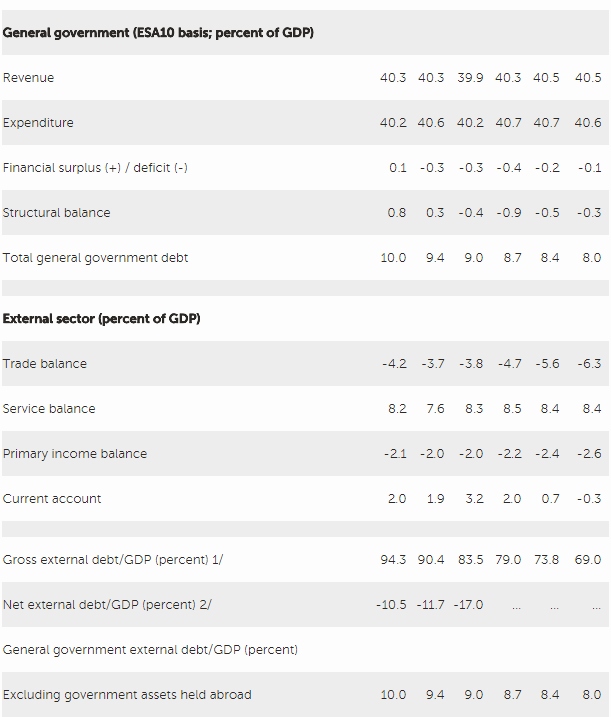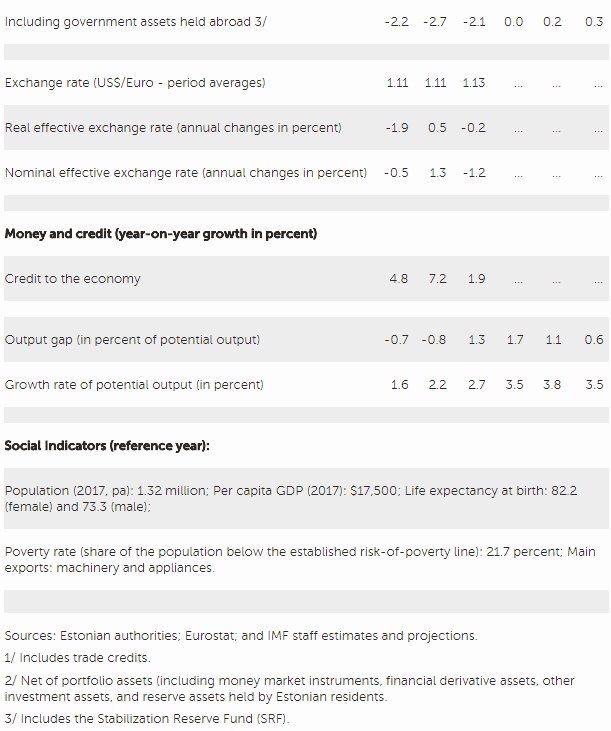Republic of Estonia: IMF Executive Board Concludes 2018 Article IV Consultation
On May 22, 2018, the Executive Board of the International Monetary Fund (IMF) concluded the Article IV consultation with the Republic of Estonia, and considered and endorsed the staff appraisal without a meeting.
The economy of Estonia is gathering steam after several years of subdued growth. Real GDP grew by 4.9 percent in 2017, more than double the rate achieved a year earlier. Growth remains broad-based, and supported by strong private and public investment—the latter partly reflecting increased absorption of EU structural funds—and favorable external conditions. However, output runs above its sustainable level, and supply-side constraints are becoming more binding. Private consumption remains subdued, reflecting to some extent the impact of rising inflation on real wages. HICP inflation declined to 3.2 percent in the first quarter of 2018, but was well above the EU average throughout 2017, mostly driven by higher food and oil prices, one-off excise tax hikes, services, and wage increases. The external position remains substantially stronger than implied by medium-term fundamentals and desirable policies.
The outlook is positive. Over the medium term, growth is set to remain around 3.5 percent, supported by the continuing recovery of main trading partners, domestic investment, accommodative financial conditions, and continued strong market sentiment. Wage growth is projected to decline slightly in 2018, while labor market structural reforms are expected to alleviate constraints on labor supply, but also to contribute to higher unemployment in 2018.
Inflation is expected to decelerate to 3 percent at the end of 2018, in line with expected stability in food prices and a slowdown in energy price rises. Going forward, GDP growth is projected at 3.9 percent in 2018 and 3.2 percent in 2019, driven by private consumption (further strong wage growth and income tax cuts) and continued strong investment. However, potential growth over the medium term is forecast at about 3 percent, constrained by labor supply and slow productivity growth. Risks arise mainly from international economic policy uncertainty in advanced countries, possible spillovers from Nordic countries’ real estate and financial markets, and a continued wage growth, which going forward could impact adversely competitiveness.
Executive Board Assessment
In concluding the Article IV consultation with the Republic of Estonia, Executive Directors noted:
Macroeconomic policies should focus on supporting economic growth and structural reforms. In the context of a continued positive output gap, rising inflation pressures and a tightening labor market, a broadly neutral fiscal policy that protects productivity-enhancing investments would be appropriate. The favorable domestic and external environment should be used to accelerate reforms. Given the macro-financial developments, sustained prudent oversight would help prevent an unwarranted relaxation of credit standards, and continued carefully monitoring of macro-financial developments would help to update macro-prudential policies as needed.
A broadly neutral fiscal policy that protects structural reforms would be in line with economic conditions. The authorities should seek to unwind some of the large positive fiscal impulse embedded in the 2018 budget. While spending to enhance productive potential and support structural reforms is worthwhile to boost economic potential, low-priority capital spending could be deferred to ease pressures on the already-stretched construction sector. Current expenditure could also be rationalized wherever possible to streamline bureaucracy and accelerate savings from existing programs, and the recently piloted spending reviews could be advanced to identify potential efficiency gains. In the meantime, reallocating resources within the budget could help to scale-up the funding of some supply-side measures. Also, converting the current land tax into a market-based property tax could be envisaged to further mobilize resources without boosting the tax wedge.
Wage growth needs to be anchored gradually by fundamentals. Policies can contribute to this goal by ensuring that increases in public wages and in the minimum wage do not put undue pressure on private wages. Leaning against the demographic decline of labor by releasing labor resources from the relatively large government sector faster and from accelerated disability reform, allowing more immigration, and boosting female participation rates by reducing gender pay gap would also be helpful. In that context, the recent agreement by social partners on a formula to guide minimum wage raises by linking them in part to productivity, with a cap of 40 percent of the average wage, is welcome.
Raising productivity and boosting labor supply will be key to increase potential growth. While the budget stance should be neutral going forward, sustained increases of productivity-enhancing investments, accompanied by measures aimed at strengthening the institutional framework for selection and appraisal of public infrastructure projects, would be welcome. Beyond participation, skills shortages and mismatches remain. In this regard, current and planned efforts to strengthen the education system and align it with labor market needs are commendable.
Programs to boost firms’ innovative capacity and value addition, and to support the building of economic clusters around key technologies, notably information communications technology (ICT), are also commendable and should be broadened and accelerated where possible.
Maintaining a prudent approach to financial supervision and being prepared to use macro-prudential policies proactively if needed to address risks is critical in the current cyclical upswing. The countercyclical capital buffer, which is set to zero, is appropriate for the current stage of the cycle. Consumer credit developments need to continue to be monitored carefully. Bank risk weights should remain under scrutiny to ensure they reflect underlying risks appropriately. Developments in cross-border banking linkages indicate that potential spillovers from vulnerabilities in Nordic parent banks, notably the Swedish real estate sector, require further safeguards for financial stability, notably in cross-border banking supervision through the Nordic-Baltic cooperation platform.



Source: International Monetary Fund
- 241 reads
Human Rights
Ringing FOWPAL’s Peace Bell for the World:Nobel Peace Prize Laureates’ Visions and Actions

Protecting the World’s Cultural Diversity for a Sustainable Future

The Peace Bell Resonates at the 27th Eurasian Economic Summit

Declaration of World Day of the Power of Hope Endorsed by People in 158 Nations

Puppet Show I International Friendship Day 2020

